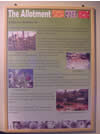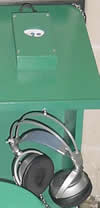![[East Midlands Oral History Archive logo]](../../images/logo.gif) |
Museums |
||
|
|
|||
Museums
Oral history can be an effective way to add to museum exhibitions. The use of a few short (no more than 5 minutes), well chosen oral history extracts can make your objects come to life. However technical and security problems sometimes seem to pose insurmountable problems in actually being able to let people hear the sound. Below you will find some possible solutions that will enable you to add an oral history component to your museum.
[Transcriptions] [Speakers] [Headphones and handsets] [Computers and more complex solutions]
Transcriptions
CD/Tape Player and Speakers
The problem with using speakers to play your audio is that it can be very intrusive. It will work best in a small room where visitors are not asked to read any interpretation. If you try to place audio in a section of a larger gallery you are likely to find that the sound bleeds accross to the rest of the exhibits in the gallery. We would suggest that you edit a short oral history extract (see using sound editing software) and put it on repeat so that people standing in the room for a relatively short time will hear all of the extract.
CD/Tape Player and Headphones/Handsets
Paul Sheldon of Nottingham Brewerhouse Museum sells units made from a CD walkman and a telephone handset for around £200. With these units visitors just have to pick up a handset to hear an extract. The extract will stop when the handset is put down. Contact Paul Sheldon on 0115 915 3608 or paul@psheldon.fsbusiness.co.uk for further information.
Computers, Kiosks and Outsourcing
The following companies sell these kinds of products and offer more complex listening post installations. We have not worked directly with any of these companies and so they should not be considered to be approved or recommended by the East Midlands Oral History Archive. We would like to hear from any other companies that offer similar services.

Warwickshire Museum Service used oral history transcriptions on display boards in a recent exhibition.

Warwickshire Museum Service constructed a listening post using a walkman and a sturdy pair of headphones.
|
|
|
![[search]](../../images/buttons/search.gif)
![[Hosted by the University of Leicester]](http://www.le.ac.uk/corporateid/navigation/hostedby.gif)
![[University Home]](http://www.le.ac.uk/corporateid/navigation/unihome.gif)
![[EMOHA Homepage]](http://www.le.ac.uk/corporateid/navigation/archive.gif)
![[contact the East Midland Oral History Project]](http://www.le.ac.uk/corporateid/navigation/contact.gif)